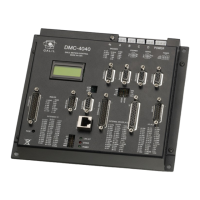Trial # Phase A Phase B Phase C + Velocity - Velocity
1
2
3
4
5
6
Table 2.12: Table provided for use with swapping motor phases to achieve trapezoidal communication
Trial # Hall A Hall B Hall C + Velocity - Velocity
1
2
3
4
5
6
Table 2.13: Table provided for use with swapping hall leads to achieve trapezoidal communication
9. Check that the motor phases and encoder feedback are in proper polarity to avoid a runaway condition. Do
so by watching the different hall transitions by using the QH command and rotating the motor by hand in an MO
state. If the motor and encoder polarity are correct than TP A should report a smaller number when QH A
reports 1 than when QH A reports 3. If TP A is larger when QH A reports 1 than 3, then the motor is in a
positive feedback state and will runaway when sent movement commands; Reverse the encoder feedback as
described in Step 6. Connecting Encoder Feedback, pg 19.
10. Issue MO A and set OFA= 0. Set small, and appropriate values of KP A and KD A and verify the motor
holds position once a SH A is issued. The motor is now under closed loop control.
11. Double check commutation by issuing a small jog command (JGA=1000; BG A) and verify the motor
spins smoothly for more than 360 degrees. If the user monitors QH during the jog movement it should report a
number 1-6 transitioning through the following sequence: 1, 3, 2, 6, 4, 5 and repeating.
12. If no runaway occurs, the motor is ready to be tuned. Skip to Step 10. Tune the Servo System, pg 32.
Sinusoidal Commutation
The following amplifiers support sinusoidal commutation:
A4 – AMP-435x0 (-D3540,-D3520), pg 228
A5 – AMP-43640 (-D3640), pg 235
A6 – AMP-43740 (-D3740), pg 241
Galil provides several sinusoidal commutation methods. The following list provides a brief description of how each
method works and Table 2.14 discusses the pros and cons of each. Detailed instructions for each method follow on
pg 27.
Chapter 2 Getting Started ▫ 26 DMC-40x0 User Manual

